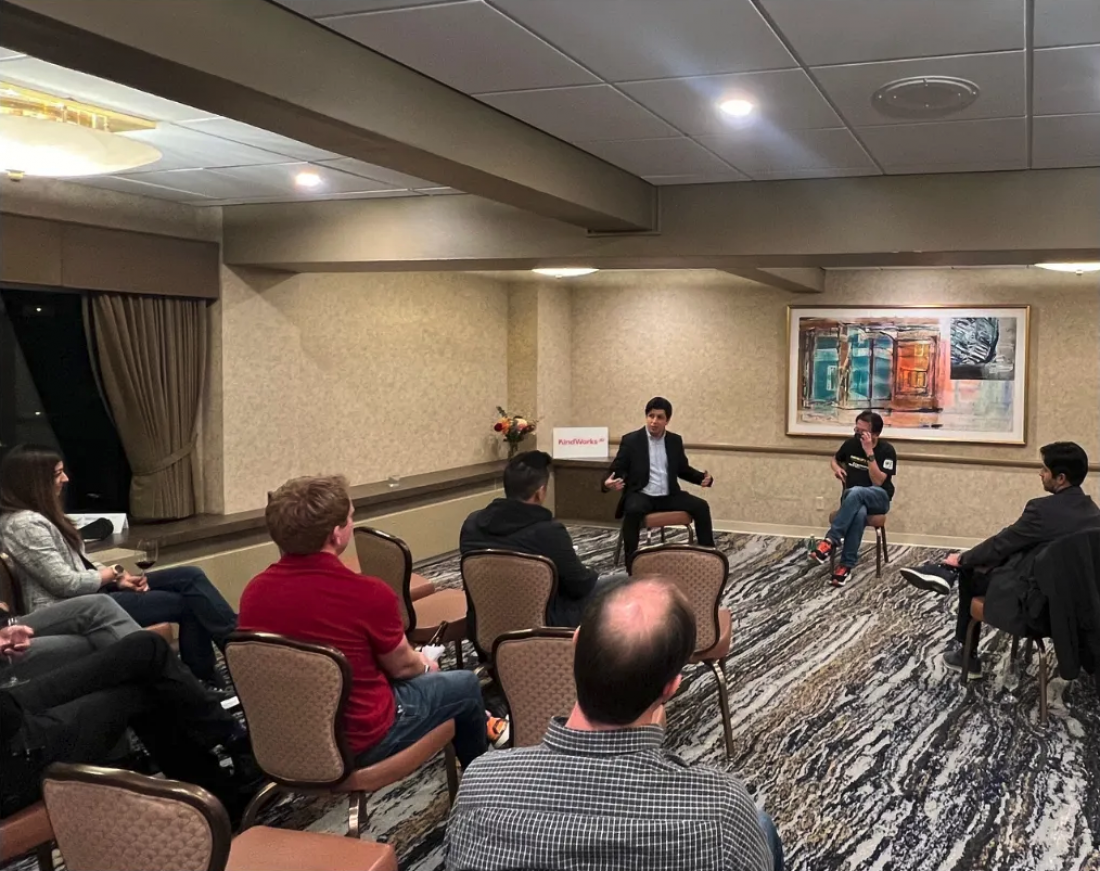I recently came across a professional and personal declaration that I created in 2019 when I was starting a new role. In it, I write that my professional goals are to ‘grow brands and industries that I have passion for’ and ‘develop people through empathy, listening, leading by example.’ At the time, I had never heard of KindWorks.AI. I feel incredibly lucky that today I am living my goals at KindWorks at a level that I could not have imagined when I wrote that declaration in 2019. I get to have discussions every day about building a brighter future of work through empathy, listening, and Kindness.
I recently participated in one such discussion in Silicon Valley as part of our ‘Building a Brighter Future of Work’ series. Our attendees and esteemed panelists all shared their enthusiasm for the important discussions and the new ideas about how to motivate talent and help everyone find purpose and impact in their work. We discussed the importance of intentionality, listening, transparency, and Kindness at work and how your business and product is a reflection of your culture.
I pinch myself that this is my job. I aspire to help build workplaces and a world where everyone can articulate and live their own goals. Our conversations with top executives from Microsoft, Google, Uber, and Cisco were inspiring to me and I hope you find some of our discussion points below helpful for your business too.
Intrinsic motivation is critical, and every person is different
Often managers can make assumptions about what motivates individual members of their team. This is a mistake that managers cannot afford to make. It is critical to remember that each team member is an individual with personal priorities, goals, and motivations for why they have chosen the role and company that they are currently in.
When someone new starts on your team, have a transparent conversation about what they are hoping to achieve in the new role. Spend the time to truly listen and understand what has motivated them and what will keep them motivated. In the same conversation, also share what the company is hoping to achieve with the role and team member and find the overlaps and synergies that will make everyone successful together. Then, plan regular check-ins with the employee. Protect that time to discuss progress against the individual’s personal goals and priorities and to share progress and alignment with the company.
Measure on accomplishments over activity
Consistent ways to measure employees is important both to give feedback and to know if goals are being achieved. It can be easy to fall into the trap of measuring employees based on their activity. It’s straightforward to count keystrokes, time at the desk, and administrative tasks. However, to create a workplace where employees are motivated to innovate, challenge, and deliver their best work, measuring on activity can actually deter creativity and productivity. When employees feel that they are being watched by big brother, they do not feel trust to take risks and the workplace loses psychological safety.
It might be more complicated to measure on accomplishments because it can be more difficult to track and compare these consistently. However, recognizing accomplishments over time at the desk creates a culture driven by more motivated employees and creativity.. This in turn can create a cycle of increased confidence, collaboration, and improved teamwork..
As a manager, stay close and connected to your team
This may seem obvious, but it too often becomes something that drops from priority when things get busy. Finding the opportunities to stay close and connected to one’s team proves even more challenging in hybrid or remote workspaces. It is still possible to build bonds and stay closely connected to team members even when you might not be sitting side by side, but it takes extra intentionality and thoughtful prioritization.
Ensure line managers have agency and resources to motivate their people
The saying that ‘people don’t quit jobs, they quit bosses’ is a saying for a reason. A really bad boss can make life miserable. But even decent bosses who don’t make the effort to support their team members, will lose their people at a more rapid pace. Each individual team member is motivated in different ways and it’s up to the manager to learn those motivations and then take the initiative to maintain a positive atmosphere across the team.
The ability for line managers to have the agency and resources to be able to act on this is dependent on the company priorities. When a company culture prioritizes recognizing the humanity in their employees, that theme trickles down through each manager and team member. This prioritization of individuality and agency is critical to start with the most senior leaders. The company must live through example and through action so that the organization sees the authenticity and can model those motivational behaviors at every level.
Your product is a reflection of your team culture
When your team culture is strong, your output is strong. When your culture is suffering, your product is suffering.
It might seem that productivity is driven transactionally, but productivity is only strong when human motivation is strong. And, motivation is strongest when people feel purposeful and impactful in what they are doing. When someone is engaged with their workplace, their coworkers, and their work, their productivity is much stronger.
Companies cannot afford to NOT invest in their culture because a poor team culture results in a poor product.
Small gestures can be just as effective (or more so) than large ones
Many companies wait until only a few touchpoints per year to connect with their employees, but it’s the daily activities that matter the most. A fantastic holiday party or an annual review has a place in creating a culture of engaged employees, but people want to feel appreciated, recognized, and connected in their daily work more than they want to have one day of fun or feedback.
In a fast-paced world, it can become easy for days, weeks, or even months to go by and not have prioritized our people. As humans, people want to feel that we are appreciated as people and more than simply company resources. This means that adding a dimension of human connection into daily transactional conversations makes the largest impact and boosts the highest levels of connectivity and engagement across the workplace.
Consistent practices of Kindness accelerate cultural transformations
Kindness doesn’t mean ‘just be nice’. It often means a step outside of our comfort zone. It can mean having a difficult conversation such as giving feedback on a performance issue or saying ‘no’. It means always communicating with sincerity and compassion, treating the other party with empathy, and having positive intention no matter the situation or conversation.
When we prioritize Kindness, we change foundational elements of our cultural practices. We transform our workplaces to be places (virtual and physical places) where people WANT to come to work. They are places where everyone finds connection and growth opportunities and is motivated to go above and beyond.
If you are interested in learning more about KindWorks.AI and how we can partner to boost employee morale, retain talent, and transform culture by tackling the root causes, I’m always happy to connect.

